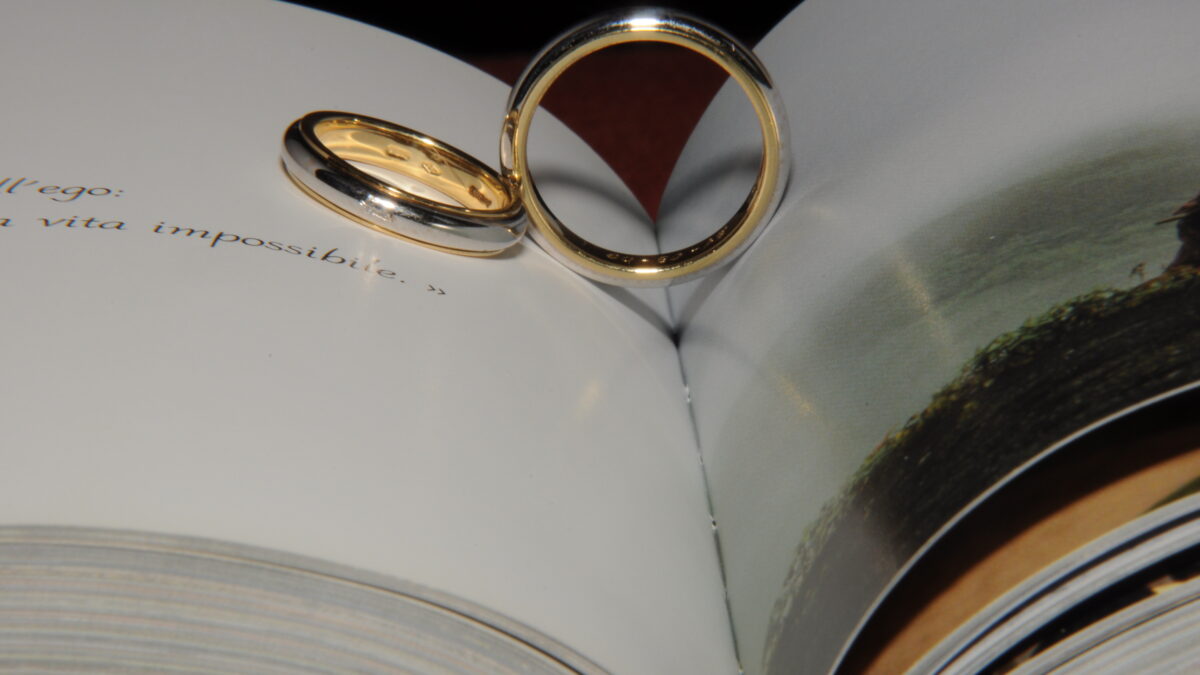
There’s a great deal of confusion today about what the actual divorce rate is in the United States. There are lots of opinions—some of them offered with great confidence, but with very little true insight or accuracy.
Some say it’s around 50 percent. Others say it’s nowhere close to that. Some incorrectly believe the 50 percent number is derived from a comparison of the number of weddings and divorces in a given year. But no serious scholar or demographer has ever measured divorce rates that way.
Only a small handful of family scholars seem sure about what the current divorce rate actually is. But it doesn’t need to be this way: it’s important we know the actual divorce rate, so we have a sober understanding of the state of marital longevity.
As it turns out, a detailed look at marriage and divorce statistics reveals both good and bad news. In fact, there is some remarkably good news: many people marrying today actually have a nearly zero risk of divorce. Before we look at that, however, let’s establish what the actual divorce rate is and why so many different, and often wildly conflicting, numbers are bandied about.
There are four main ways scholars measure current divorce rates, and these four main measurements provide four very different numbers, because they examine the elephant from different angles. Let’s start with the lesser used measures and conclude with the most popular, which leads us to the very good news. The explanation of these four is drawn from the work of Professor Paul R. Amato, who leading sociologists go to for insight on such issues.
1. There’s the Crude Divorce Rate
This number refers to the number of divorces per 1,000 people in a population at a given time. The crude divorce rate is currently around 3.6 divorces for every 1,000 people in the US, regardless of age.
Pro: This measure provides the largest-scale snapshot of divorce prevalence in a population and makes it easy to compare divorce rates of different countries.
Con: This number isn’t very useful, since it includes all people, even those—such as children, the unmarried, and elderly couples—who are not at risk for divorce.
2. There’s the Percent Ever Divorced
This rate is precisely what it says it is: the percentage of ever-divorced adults in a population. This, of course, is not an annual rate. Currently, about 22 percent of women and 21 percent of men have ever been divorced. Of course, some of the “ever divorced” population has remarried. Which means 11 percent of women and 9 percent of men are currently divorced—that is, they are divorced and remain single.
Pro: This is a very straightforward, easy-to-understand measure.
Con: As it includes all divorces, it includes those who married badly then divorced—perhaps when very young—and are now in a strong, enduring marriage of many decades. It also fluctuates relative to the general marriage rate.
3. We Can Look At the Refined Divorce Rate
This is the number of divorces per 1,000 married women. Like the crude rate, it’s an annual rate. As Amato explains, “An advantage of the refined divorce rate is that it has a clear interpretation. That is, dividing the rate by 10 yields the percentage of marriages that end in divorce every year.” So, the refined annual divorce rate is currently 1.9 percent.
Pro: This is a very precise annual number, that gives the rate of divorce as a subset of the actual married population, the proper comparison.
Con: It doesn’t give the bigger, longitudinal number of divorces over time.
4. Or We Can Look At the Cohort Measure Rate
This is the “40-50 percent” number that most people speak of. It is not a hard, objective number, but an educated projection—somewhat like measured projections that insurance companies make about life expectancy. It provides a sophisticated estimation of the general risk of divorce for those marrying today. Amato explains,
Demographers … examine the percentage of people married for one year who divorced in the previous year, the percentage of people married for two years who divorced in the previous year, and so on. These duration-specific rates are combined through life table methods to yield the cumulative proportion of couples projected to divorce.
There are various generational life factors that impact this number from decade to decade, because certain qualities and external factors vary among generations: robustness of the national and local economy, job strength, sexual mores, overall college attendance and graduation, cohabitation rates, etc.
Currently, the cohort measure is typically calculated as being in the 40-50 percent range for couples entering their first marriage. Both Amato and Scott Stanley from the University of Denver place it more specifically in the 42-45 percent range for those marrying today. Stanley explains that
… young married adults are not divorcing at the same rate as their parents did at similar ages, so it is likely that the divorce rate will decline in the future, once the Baby Boomers (who were and continue to be highly divorce prone) leave the population. Thus, as others have suggested, the future may well be brighter than the 42 to 45 percent risk estimate suggests, but we do not yet know this will be the case.
Stanley is correct. The divorce rate leveled off at a very high rate in the mid-1980s and has generally remained steady at that rate ever since. In fact, some demographers argue it has even declined a bit in the last 10 years. Like Stanley, they believe it will likely continue to decline even more, but not in a significant way.
Pro: This is the measure most scholars use and most widely known, giving the larger picture of the overall marital lifetime expectation.
Con: It doesn’t give an objective number of actual divorces.
How Personal Factors Influence Your Risk of Divorce
But here is the most important news concerning one’s life-time risk of divorce. While the 40-50 percent divorce risk number is indeed correct, it actually applies to no one. How can that be?
There are a handful of personal factors that sociologists have determined significantly affect one’s overall risk of divorce, for good or ill. This means many couples will have a significantly higher or lower lifetime risk of divorce than the average. For a good number of couples marrying today, their risk of divorce is nearly zero. That’s a story worth telling. Others will face a substantial uphill battle, largely due to the choices they make before they even marry.
Here’s a list of most of the major life-factors that impact a couple’s risk of divorce:
- Cohabitation: Cohabiting couples have a 50-80 percent higher likelihood of divorce than non-cohabiting couples.
- Age: Those who marry after age eighteen have a 24 percent reduced risk of divorce.
- Age Difference: Marriages where there is a significant difference in age have twice the risk of divorce than those in which the couples are close in age.
- Education: Only 27 percent of college graduates will divorce by middle age.
- Premarital Counseling: Couples who have gone through a marriage education course before marrying are generally up to 30 percent more likely to enjoy marital success.
- Family Background: Having parents who have never divorced reduces divorce risk by 14 percent.
- Marital History: Being previously divorced markedly elevates one’s risk of subsequent divorce.
- Income: Having a collective annual household income of $50,000 or more is associated with a 30 percent lower divorce risk.
- Beliefs: Going into a marriage with husband and wife holding a strong personal conviction that marriage is for life protects substantially against divorce.
- Religion: Those with a strong common faith and regularly attend religious services are 47 percent less likely to divorce. However, sharing a nominal faith has no protective effect.
- Childbearing: Having one’s first child after marriage can reduce one’s divorce risk by 24 to 66 percent.
- Desire for Children: A marriage in which the wife desires children but the husband does not is at a 50 percent greater risk of divorce.
- Sexual History: Marrying as non-virgins is associated with “considerably higher” risk of divorce and “dramatically more unstable first marriages,” as one leading researcher explains.
- Smoking: Couples in which one partner smokes and the other does not are markedly more likely to divorce compared to couples in which neither spouse does. Marriages in which both smoke were more than twice as likely to dissolve compared with non-smoking couples.
How Many Burdens Are You Bringing to Your Marriage?
So while the 40-50 percent projected rate of divorce risk is true and reliable, there are important personal characteristics that put everyone at very different levels of risk, some dramatically so. Many people of serious faith and practice, even with some of the above risks, have a tremendously high likelihood of lifelong marital success because of their views regarding sex outside of marriage, resistance to cohabitation, the sacred, covenantal nature of marriage, and marriage’s importance as a vocation.
Many others, given the age we live in, will have a greater number of these troubling factors. The presence of these factors is certainly not destiny or unavoidable destruction. But they can and often do present additional challenges for newly married couples. Think of them as rocks placed in your backpack on the journey of marriage. It can be helpful to be aware of the extra burdens you bear, and seek help in overcoming them.
Often, a remedy that is both powerful and simple is for young couples to find an older couple—one who has successfully overcome the struggles of married life—who can accompany you and your spouse. They can lighten your load with sage advice, encouragement, and correction when needed. Older, co-journeying couples also serve as a great protection against the sense of shame and isolation that can poison marriages.
It is important that those of us who care about the state of the family today have a realistic view of its strengths and weaknesses. Hopefully data like this will help.









